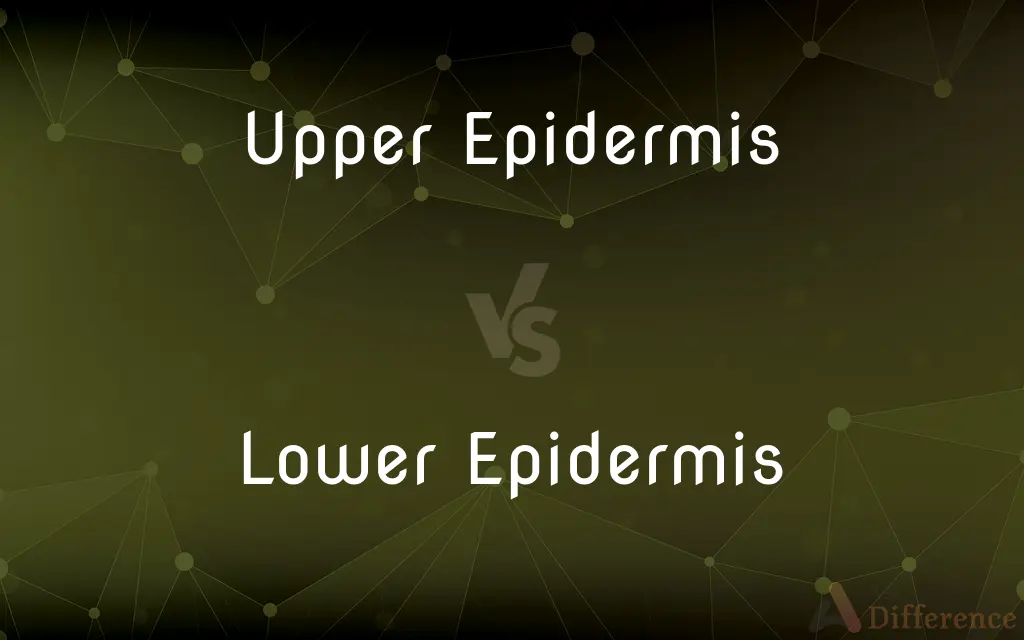Upper Epidermis vs. Lower Epidermis — What's the Difference?
By Tayyaba Rehman — Published on January 18, 2024
The upper epidermis is the topmost layer of a plant leaf, typically thicker and with fewer stomata than the lower epidermis, which is the bottom layer and usually has more stomata for gas exchange.

Difference Between Upper Epidermis and Lower Epidermis
Table of Contents
ADVERTISEMENT
Key Differences
The upper epidermis of a plant leaf is the outermost layer, serving as a protective barrier against environmental factors like water loss and pathogen entry. The lower epidermis, located on the underside of the leaf, primarily functions in facilitating gas exchange with its higher stomata density.
Typically, the cells in the upper epidermis are more tightly packed and may be covered with a waxy cuticle to reduce water loss. In contrast, the lower epidermis has more loosely arranged cells and a thinner or absent cuticle, optimizing gas exchange.
The upper epidermis is often clear and non-photosynthetic, allowing light to pass through to the photosynthetic cells beneath. The lower epidermis, while also transparent, contains more stomata that are crucial for photosynthesis-related gas exchange.
In many plants, the upper epidermis is thicker to provide more protection from the sun's intensity and other aerial threats. Conversely, the lower epidermis is generally thinner, adapting to the less intense light and microclimate found on the leaf's underside.
The structural differences between the upper and lower epidermis are a result of their distinct functional roles in the plant's survival and adaptation to its environment.
ADVERTISEMENT
Comparison Chart
Location
Topmost layer of the leaf
Bottom layer of the leaf
Function
Protection from environmental factors
Facilitating gas exchange
Stomata Density
Fewer stomata
More stomata
Thickness
Typically thicker
Generally thinner
Cuticle Presence
Often has a thicker waxy cuticle
Thinner or absent cuticle
Compare with Definitions
Upper Epidermis
Top layer of leaf
The upper epidermis protects the leaf from excessive sunlight.
Lower Epidermis
Adapted for gas exchange
Stomata in the lower epidermis facilitate CO2 intake.
Upper Epidermis
Non-photosynthetic
Light passes through the clear, non-photosynthetic upper epidermis.
Lower Epidermis
Higher stomata density
More stomata are found in the lower epidermis.
Upper Epidermis
Protective barrier
The upper epidermis of the leaf is key in preventing water loss.
Lower Epidermis
Thinner structure
The lower epidermis is thinner than the upper layer.
Upper Epidermis
Fewer stomata
In the upper epidermis, stomata are less prevalent.
Lower Epidermis
Bottom layer of leaf
The lower epidermis has specialized cells for gas exchange.
Upper Epidermis
Waxy cuticle presence
The waxy cuticle on the upper epidermis reduces dehydration.
Lower Epidermis
Less protective cuticle
The lower epidermis often lacks a thick cuticle.
Common Curiosities
What is the main function of the upper epidermis?
The upper epidermis serves as a protective barrier against environmental elements.
Why does the upper epidermis have fewer stomata?
Fewer stomata reduce water loss, aiding in the protection of the plant.
What role does the lower epidermis play in a plant?
The lower epidermis primarily facilitates gas exchange necessary for photosynthesis.
What is the significance of the waxy cuticle on the upper epidermis?
The waxy cuticle helps minimize water loss through evaporation.
How does the lower epidermis contribute to photosynthesis?
It allows gas exchange through stomata, providing CO2 for photosynthesis.
Can the number of stomata vary between different plants?
Yes, stomata density can vary based on environmental conditions and plant types.
Are cells in the upper epidermis photosynthetic?
Generally, they are not; their main function is protection.
Is the lower epidermis thicker than the upper epidermis?
No, the lower epidermis is generally thinner compared to the upper epidermis.
Do both the upper and lower epidermis contain chloroplasts?
Typically, neither layer contains many chloroplasts; they are mainly transparent.
Is the upper epidermis the same in all plants?
While structurally similar, the thickness and cuticle can vary among plant species.
Does the lower epidermis play a role in transpiration?
Yes, transpiration occurs through the stomata primarily located in the lower epidermis.
Do both epidermises help in regulating plant temperature?
Indirectly, yes, through processes like transpiration and protection from heat.
Can environmental factors affect the structure of these epidermises?
Yes, factors like light, water availability, and temperature can influence their structure.
Is the upper epidermis visible to the naked eye?
It's usually visible as the outermost layer of the leaf.
Are there any special cells in the lower epidermis?
Yes, guard cells surrounding stomata are specialized cells in the lower epidermis.
Share Your Discovery

Previous Comparison
Tollywood vs. Bollywood
Next Comparison
Blue Dream vs. Pineapple ExpressAuthor Spotlight
Written by
Tayyaba RehmanTayyaba Rehman is a distinguished writer, currently serving as a primary contributor to askdifference.com. As a researcher in semantics and etymology, Tayyaba's passion for the complexity of languages and their distinctions has found a perfect home on the platform. Tayyaba delves into the intricacies of language, distinguishing between commonly confused words and phrases, thereby providing clarity for readers worldwide.













































